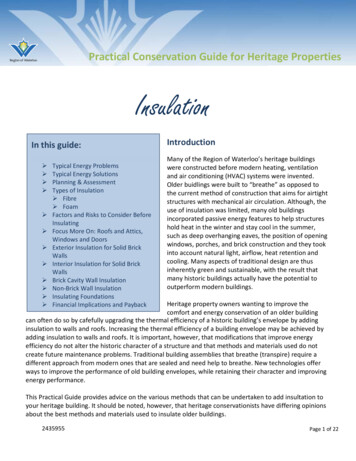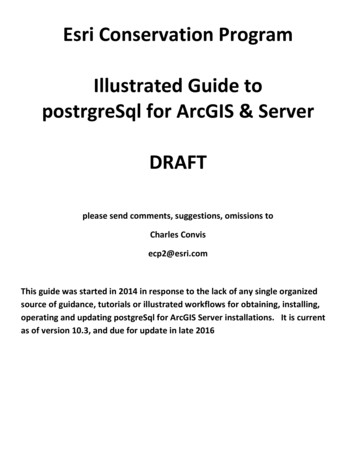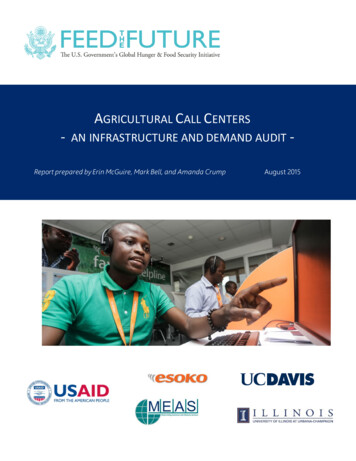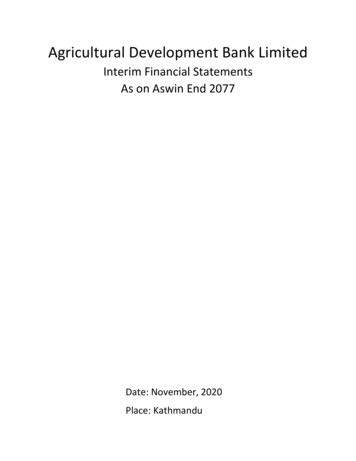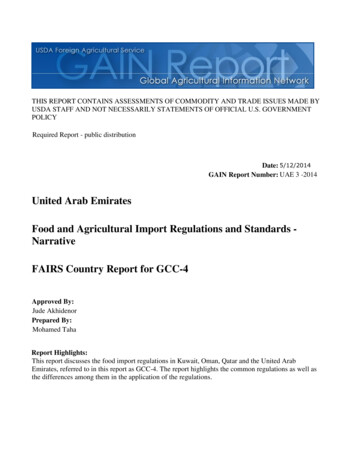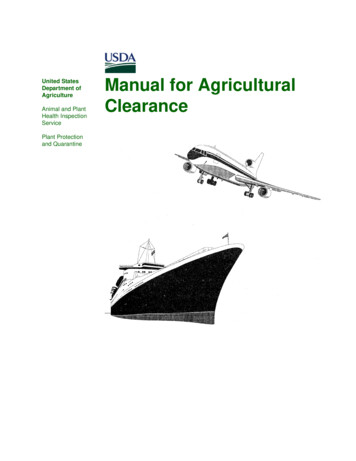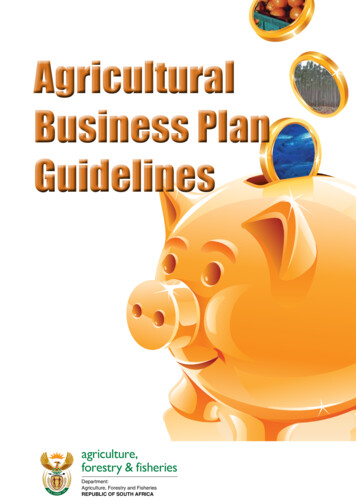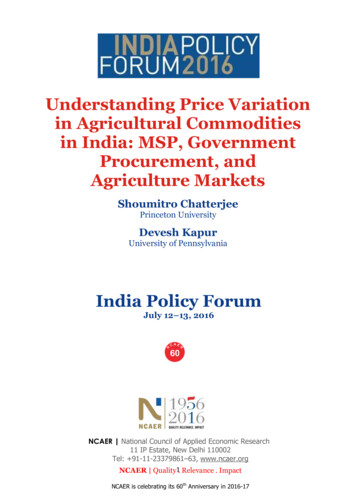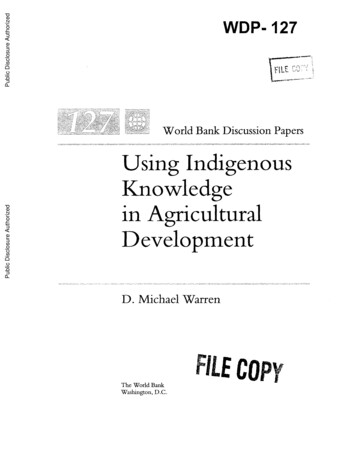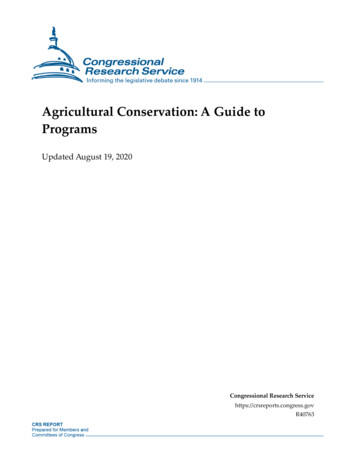
Transcription
Agricultural Conservation:A Guide to ProgramsMegan StubbsSpecialist in Agricultural Conservation and Natural Resources PolicyJuly 13, 2017Congressional Research Service7-5700www.crs.govR40763
Agricultural Conservation: A Guide to ProgramsSummaryThe Natural Resources Conservation Service (NRCS) and the Farm Service Agency (FSA) in theU.S. Department of Agriculture (USDA) currently administer close to 20 programs andsubprograms that are directly or indirectly available to assist producers and landowners who wishto practice conservation on agricultural lands. The differences and number of these programshave created general confusion about the purpose, participation, and policies of the programs.While recent consolidation efforts removed some duplication, a large number of programsremain. The programs discussed in this report are as follows: Agricultural Conservation Easement Program (ACEP)Agricultural Management Assistance (AMA)Conservation Operations (CO); Conservation Technical Assistance(CTA)Conservation Reserve Program (CRP)CRP—Conservation Reserve Enhancement Program (CREP)CRP—Farmable Wetland ProgramConservation Stewardship Program (CSP)Emergency Conservation Program (ECP)Emergency Forest Restoration Program (EFRP)Emergency Watershed Protection (EWP)Environmental Quality Incentives Program (EQIP)EQIP—Conservation Innovation Grants (CIG)Grassroots Source Water Protection ProgramHealthy Forests Reserve Program (HFRP)Regional Conservation Partnership Program (RCPP)Voluntary Public Access and Habitat Incentive ProgramWater Bank ProgramWatershed and Flood Prevention OperationsWatershed Rehabilitation ProgramThis tabular presentation provides basic information covering each of the programs. In each case,a brief program description is followed by information on major amendments in the AgriculturalAct of 2014 (P.L. 113-79, 2014 farm bill), national scope and availability, states with the greatestparticipation, the backlog of applications or other measures of continuing interest, programfunding authority, FY2017 funding, FY2018 Administration budget request, statutory authority,the authorization expiration date, and a link to the program’s website.Congressional Research Service
Agricultural Conservation: A Guide to ProgramsContentsIntroduction . 1Overview . 22014 Farm Bill. 3Unfunded and Repealed Programs . 4Conservation Programs . 5Agricultural Conservation Easement Program (ACEP) . 6Agricultural Management Assistance (AMA) . 7Conservation Operations (CO)—Conservation Technical Assistance (CTA) . 8Conservation Reserve Program (CRP) . 9CRP—Conservation Reserve Enhancement Program (CREP) . 10CRP—Farmable Wetland Program .11Conservation Stewardship Program (CSP) . 12Emergency Conservation Program (ECP) . 13Emergency Forest Restoration Program (EFRP) . 14Emergency Watershed Protection (EWP) . 15Environmental Quality Incentives Program (EQIP) . 16EQIP—Conservation Innovation Grants (CIG) . 17Grassroots Source Water Protection Program . 18Healthy Forests Reserve Program (HFRP) . 19Regional Conservation Partnership Program (RCPP) . 20Voluntary Public Access and Habitat Incentive Program . 21Water Bank Program . 22Watershed and Flood Prevention Operations . 23Watershed Rehabilitation Program . 24TablesTable 1. Unfunded and Repealed Programs . 4ContactsAuthor Contact Information . 24Congressional Research Service
Agricultural Conservation: A Guide to ProgramsIntroductionThe U.S. Department of Agriculture (USDA) administers a number of agricultural conservationprograms that assist private landowners with natural resource concerns. These include workingland programs, land retirement and easement programs, watershed programs, emergencyprograms, technical assistance, and other programs. The number and funding levels foragricultural conservation programs have steadily increased over the past 60 years. Earlyconservation efforts undertaken by Congress were focused on reducing high levels of soil erosionand providing water to agriculture in quantities and quality that enhanced farm production. By theearly 1980s, however, concern was growing that these programs were not adequately dealing withenvironmental problems resulting from agricultural activities (especially off the farm). In 1985,conservation policy took a new direction when Congress passed the Food Security Act of 1985(1985 farm bill, P.L. 99-198), which established the first conservation programs designed to dealwith environmental issues resulting from agricultural activities.Provisions enacted in subsequent farm bills, including in 1990, 1996, 2002, 2008, and 2014,1reflect a rapid evolution of the conservation agenda, including the growing influence ofenvironmentalists and other non-agricultural interests in the formulation of conservation policy,and a recognition that agriculture was not treated like other business sectors in manyenvironmental laws.2 Congress also began funding many of these new programs throughmandatory spending for the first time, using the borrowing authority of USDA’s CommodityCredit Corporation (CCC)3 as the funding mechanism instead of annual appropriations. Inaddition to the original soil erosion and water quality and quantity issues, the conservation agendahas continued to expand to address other natural resource concerns, such as wildlife habitat, airquality, wetlands restoration and protection, energy efficiency, and sustainable agriculture.Lead agricultural conservation agencies within USDA are the Natural Resources ConservationService (NRCS), which provides technical assistance and administers most conservationprograms, and the Farm Service Agency (FSA), which administers the Conservation ReserveProgram (CRP). These agencies are supported by others in USDA that supply research andeducational assistance, including the Agricultural Research Service (ARS), the EconomicResearch Service (ERS), the National Institute of Food and Agriculture (NIFA), and the ForestService (FS).4 In addition, agricultural conservation programs involve a large array of partners,including other federal agencies, state and local governments, and private organizations, amongothers, who provide funds, expertise, and other forms of assistance to further agriculturalconservation efforts.1Conservation and Trade Act of 1990 (P.L. 101-624), Federal Agricultural Improvement and Reform Act of 1996 (P.L.104-127), Farm Security and Rural Investment Act of 2002 (P.L. 107-171), Food, Conservation, and Energy Act of2008 (P.L. 110-246), and Agricultural Act of 2014 (P.L. 113-79).2For additional discussion on conservation in the farm bill, see CRS Report R43504, Conservation Provisions in the2014 Farm Bill (P.L. 113-79).3The CCC is the funding mechanism for the mandatory payments that are administered by various agencies of USDA,including all of the farm commodity price and income support programs. For more information on the CCC, see CRSReport R44606, The Commodity Credit Corporation: In Brief.4For more information on ARS projects, see http://www.ars.usda.gov/Research/Research.htm; ERS projects, s-environment/conservation-programs.aspx; NIFA programs, seehttp://www.nifa.usda.gov/nea/nre/nre.cfm; and FS projects, see http://www.fs.fed.us/projects/.Congressional Research Service1
Agricultural Conservation: A Guide to ProgramsOverviewUSDA provides technical and financial assistance to attract interest and encourage participation inconservation programs. Participation in all USDA conservation programs is voluntary. Theseprograms protect soil, water, wildlife, and other natural resources on privately owned agriculturallands to limit environmental impacts of production activities both on and off the farm, whilemaintaining or improving production of food and fiber. Some of these programs center onimproving or restoring resources that have been degraded, while others create conditions to limitdegradation in the future.Though programs in this report are listed alphabetically, agricultural conservation programs canbe grouped into the following categories based on similarities: working land programs, landretirement and easement programs, watershed programs, emergency programs,5 compliance,6technical assistance, and other programs and overarching provisions.USDA Agricultural Conservation ProgramsWorking Lands Programs—typically classified as programs that allow private land to remain in production, while implementingvarious conservation practices to address natural resource concerns specific to the area. Environmental Quality Incentives Program (EQIP), Conservation Stewardship Program (CSP), and Agricultural ManagementAssistance (AMA).Land Retirement and Easement Programs—land retirement programs provide federal payments to private agriculturallandowners for temporary changes in land use or management to achieve environmental benefits. Conversely, conservation easementsimpose a permanent or long-term land-use restriction that is voluntarily placed on the land in exchange for a government payment. Conservation Reserve Program (includes the Conservation Reserve Enhancement Program (CREP) and Farmable WetlandProgram), Agricultural Conservation Easement Program (including agricultural land easements and wetland reserve easements),and Healthy Forests Reserve Program (HFRP).Watershed Programs—NRCS partners with local sponsors to carry out activities for soil conservation; flood prevention;conservation, development, utilization, and disposal of water; watershed surveys; and dam rehabilitation. Watershed and Flood Prevention Operations (also referred to as the Small Watershed Program or P.L. 566 and P.L. 534) andWatershed Rehabilitation program.Emergency Programs—provide disaster assistance for farmland rehabilitation and impairments to watersheds. Programs are usuallyfunded through supplemental appropriation acts. Emergency Conservation Program (ECP), Emergency Forest Restoration Program (EFRP), and Emergency WatershedProtection (EWP) program (includes floodplain easements).Compliance—provisions that prohibit a producer from receiving many federal farm program benefits (including conservationassistance and crop insurance) when conservation program requirements for highly erodible lands and wetlands are not met. Highly erodible land conservation (Sodbuster), wetland conservation (Swampbuster), and Sodsaver.Technical Assistance Programs—provides landowners with science-based conservation information and technical expertise (e.g.,engineering and biological) unique to the region and land use type. Usually does not include financial assistance. Conservation Operations (includes Conservation Technical Assistance, Soil Survey, Snow Survey and Water Supply Forecasting,and Plant Materials Centers).Other Conservation Programs and Provisions—Conservation Innovation Grants, Grassroots Source Water Protection Program,Regional Conservation Partnership Program (RCPP), Voluntary Public Access and Habitat Incentive Program, and Water Bank Program.5Additional information on emergency land rehabilitation programs may be found in CRS Report R42854, EmergencyAssistance for Agricultural Land Rehabilitation.6Compliance refers to a series of farm bill provisions that require a minimum level of conservation on environmentallysensitive land in exchange for access to other USDA program benefits. Compliance provisions are not discussed in thisreport. Additional analysis may be found in CRS Report R42459, Conservation Compliance and U.S. Farm Policy.Congressional Research Service2
Agricultural Conservation: A Guide to ProgramsThe majority of conservation programs are funded through USDA’s Commodity CreditCorporation (CCC) as mandatory spending. Congress authorizes mandatory programs at specifiedfunding levels (or acreage enrollment levels for CRP and CSP) for multiple years, typicallythrough omnibus legislation such as the farm bill. Mandatory programs are funded at these levelsunless Congress limits funding to a lower amount through the appropriations or legislativeprocess (or puts a ceiling on acreage that can be enrolled).7 Discretionary programs are fundedeach year through the annual appropriations process.8Despite a steady increase in mandatory funding authority, many conservation programs have beenreduced or capped through annual appropriation acts since FY2003. Many of these spendingreductions were at the request of the Administration.9 The mix of programs and amounts ofreduction have varied from year to year. Some programs, such as the CRP, have not been reducedby appropriators in recent years, while others, such as EQIP, have been repeatedly reduced belowauthorized levels. Authorized mandatory funding for conservation programs has been reduced bya total of more than 6 billion over 10 years.Sequestration has also had an effect on conservation programs. Sequestration is a process ofautomatic, largely across-the-board reductions that permanently cancel mandatory and/ordiscretionary budget authority to enforce statutory budget goals.10 Discretionary accounts haveavoided sequestration in recent years through adjustments to spending limits, however,sequestration continues on mandatory accounts. Most all mandatory conservation programs weresubject to sequestration in FY2014 through FY2017 and likely will be again in FY2018.11 Evenwith sequestration and appropriations act reductions, total annual mandatory funding forconservation programs has grown from a total of 3.6 billion in FY2006 to over 5 billion inFY2017.2014 Farm BillBefore the 1985 farm bill, few conservation programs existed, and only two would be consideredlarge by today’s standards. In contrast, leading up to the debate on the 2014 farm bill, there wereover 20 distinct conservation programs with total annual spending greater than 5 billion. Thedifferences and number of these programs created general confusion about the purpose,participation, and policies of the programs. Discussion about simplifying or consolidatingconservation programs to reduce overlap and duplication, and to generate savings, continued for anumber of years. The Agricultural Act of 2014 (P.L. 113-79, 2014 farm bill), contained several7For additional discussion on these reductions, see CRS In Focus IF10041, Reductions to Mandatory AgriculturalConservation Programs in Appropriations Law.8For additional information on the FY2016 appropriation, see CRS Report R44240, Agriculture and Related Agencies:FY2016 Appropriations.9The FY2017 Administration’s request is the first since FY2003 to not include a reduction of mandatory funding forconservation programs.10For additional information on sequestration and the budget process, see CRS Report R42972, Sequestration as aBudget Enforcement Process: Frequently Asked Questions.11The Conservation Reserve Program is statutorily exempt from sequestration (2 U.S.C. 905 (g)(1)(A)). Sequestrationreductions in FY2014 were reflected in the Congressional Budget Office (CBO) baseline that was used to write the2014 farm bill. For more information, see CRS Report R42484, Budget Issues That Shaped the 2014 Farm Bill.Sequestration estimates for FY2015, FY2016, and FY2017 may be found in the Office of Management and Budget’s(OMB) Reports to the Congress on the Joint Committee Reductions can be found at https://www.whitehouse.gov/omb/legislative reports.Congressional Research Service3
Agricultural Conservation: A Guide to Programsprogram consolidation measures, including the repeal of 12 active and inactive programs, thecreation of two new programs, and the merging of two programs into existing ones.12Unfunded and Repealed ProgramsA number of conservation programs were repealed by the 2014 farm bill or have gone unfundedby Congress in recent years. Table 1 lists these programs and the most recent congressionalaction taken.Table 1. Unfunded and Repealed ProgramsProgram NameAction-YearDescriptionAgricultural WaterEnhancement Program(AWEP)Repealed-2014A sub-program of EQIP that provided funding for water quality andquantity projects. Repealed in the 2014 farm bill and incorporatedinto RCPP.Chesapeake BayWatershed ProgramRepealed-2014Provided additional funding through existing programs toconservation projects in the Chesapeake Bay watershed. Repealed inthe 2014 farm bill and incorporated into RCPP.Conservation SecurityProgramNew enrollmentunauthorized2008Replaced by the Conservation Stewardship Program in the 2008 farmbill, the program enrolled acres in 5- to 10-year stewardshipcontracts, the last of which will expire in FY2018.Farmland ProtectionProgram (FPP)Repealed-2014An agricultural land easement program repealed in the 2014 farm bill.Program components were incorporated into the AgriculturalConservation Easement Program (ACEP).Grasslands ReserveProgram (GRP)Repealed-2014A grassland easement and contract program repealed in the 2014farm bill. Easement provisions were incorporated into ACEP andrental contracts were incorporated into CRP.Resource Conservationand Program (RC&D)DevelopmentUnfunded sinceFY2011Funded local RC&D coordinator positions. Funding terminated inFY2011 and program close-out complete in FY2012. FY2014appropriations act permanently cancelled any remaining funds.Watershed Surveys andPlanningUnfunded sinceFY2007Funded investigations and surveys of river basins to respond to waterquality, flooding, water and land management, and sedimentationproblems.Wetland ReserveProgram (WRP)Repealed-2014A wetland easement program repealed in the 2014 farm bill. Programcomponents were incorporated into ACEP.Wildlife HabitatIncentives ProgramRepealed-2014A wildlife habitat cost-share assistance program repealed in the 2014farm bill. Program components were incorporated into EQIP.Source: CRS.12For additional information on the amendments to conservation programs in the 2014 farm bill,
Watershed Rehabilitation Program This tabular presentation provides basic information covering each of the programs. In each case, a brief program description is followed by information on major amendments in the Agricultural Act of 2014 (P.L. 113-79, 2014 farm bill), national scope and availability, states with the greatest .
